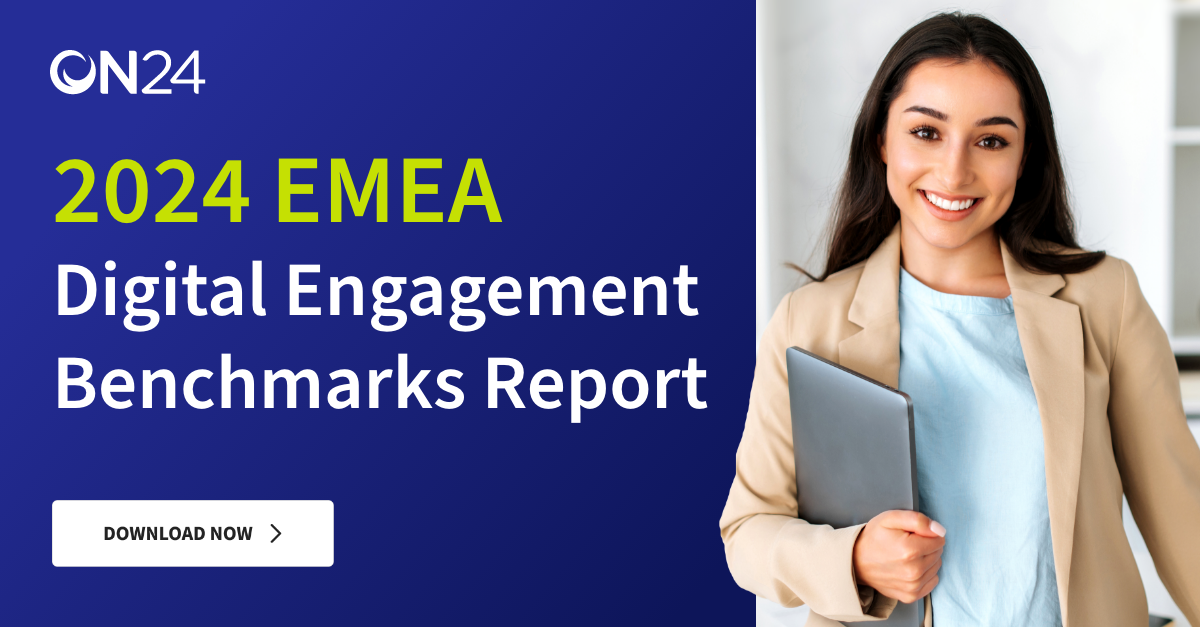5 Key Lessons from our EMEA Webinar Benchmarks Report

B2B marketers continue to juggle between meeting users’ digital demands while ensuring the quality of content. With AI creating new possibilities for marketing plans, it can be hard to determine where to pivot next.
Research from ON24 has found that EMEA-based audiences continue to demand personalized engagement, learning opportunities and interactive experiences. Our latest benchmarks report has analysed the behaviour of more than 30 million professionals to see what EMEA audiences are looking for when it comes to digital experiences.
So, how can EMEA marketers capitalize on these digital engagement trends? Here are five key lessons we’ve gleaned from our latest EMEA benchmarks report:
Digital interactions are increasing in both volume and value

EMEA audiences are engaging with content more deeply and actively than ever before. In fact, across live experiences in 2023, the number of unique digital engagement interactions per attendee increased by 8% year-over-year, while the total change since 2021 stands at 20%. Audience members crave digital conversation while sharing their opinions, feedback and preferences with peers.
But what does the rise in digital interaction mean for marketers? With engagement insights, marketing teams can determine which exact parts of their events resonate the most with audiences, leading to stronger future experiences through first-party data.
Personalization strategy is king

Audiences increasingly expect content to be tailored and relevant to their interests and preferences. The proof is in the data: there is a widening performance gap between personalised and non-personalised experiences. For example, demo requests quadrupled year-over-year in addition to a 68% increase in CTA engagement in response to personalised experiences.
It hasn’t taken long for marketers to catch on to the benefits of personalisation opportunity. In Q4 of 2023, marketers created more than four times the number of segments per digital experiences as they sought to serve relevant offers based on both buyer characteristics (e.g. firmographics, region, job title or function) and buyer behaviour.
The takeaway: when digital experiences speak to audiences, the likelihood that participants will actively show buying intent increases significantly. Unique messaging geared towards different segments of people will result in audiences who feel seen and heard, and, in turn, want to engage with marketers’ offerings.
Engagement keeps events alive well after their launch date

On average, EMEA attendees spend 53 minutes viewing and engaging with live webinars. This provides an incredible opportunity for event organisers and marketers to collect signals and data to further enhance their interactions.
However, while live webinars offer an excellent opportunity to interact with attendees in real-time, not all choose to attend live. In 2023, 44% of total attendees watched the event on-demand, or after the live date. In fact, engagement in on-demand webinars rose 13% year-over-year. This outpaces growth in engagement for live events.
That means event organisers need to be mindful that their content will live on well past their initial live date. Sales should take on-demand experiences into account when building their follow-up strategies, while experience designers need to remember this when creating content.
When it comes to finding the sweet spot for when to start promoting events, 48% of EMEA registrants registered more than a week before the event. In contrast, only 11% of the audiences registered the day of, and 21% registered more than a week before. That crucial week before the event provides an excellent opportunity to drive further engagement.
Audiences prefer engagement opportunities like learning and certifications

Once marketers figure out engagement is crucial to keeping audience members attentive, they can determine what type of engagement they want to deliver. Turns out, audiences prefer learning opportunities. 2023 showed significant growth in educational engagement, with a 21% growth in digital certifications year-over-year.
Interest in opportunities like professional certification, training, partner enablement, healthcare provider education, and member enrollment provides valuable insights—marketers should look to these as staples of the event experience. This trend will only continue to grow as digitally native professionals advance in their careers.
Attendee appetite for digital content is increasing

Downloads of resources such as e-books and white papers grew by 10% year-over-year. This means that content creators need to not just create more content, but keep in mind its relatability. Recommendations and solutions that can help with pain points are excellent ways to urge users to continue to download material.
E-books and white papers are highly effective in attracting audiences to participate in webinars, as attendance rates on sessions promoted through content hubs have more than doubled.
Once the audience attends the webinar, AI-powered analytics can be valuable in recommending assets most likely to drive conversions. For example, in the final quarter of 2023, the number of key moments identified within events more than doubled. Marketers can use these key moments to create shorter, shareable content that is easily viewed without watching the entire event.
